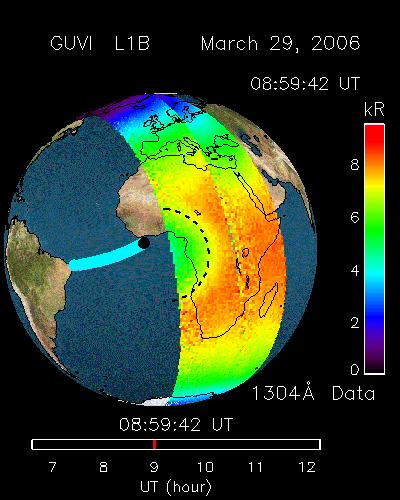Press Release
Two APL-Built Instruments Observe Recent Total Solar Eclipse
Wed, 05/24/2006 - 15:30
Space scientists from The Johns Hopkins University Applied Physics Laboratory (APL), in Laurel, Md., got a first-hand look at what happens to Earth's atmosphere when the sun was abruptly "turned off" during the March 29, 2006, total solar eclipse.
APL scientists are now modeling unique observations of the eclipse captured by two APL-built instruments and the only two active space-based ionospheric-thermospheric imagers currently in operation: the Global Ultraviolet Imager (GUVI) aboard NASA's TIMED (Thermosphere, Ionosphere, Mesosphere Energetics and Dynamics) spacecraft, built and operated by APL; and the Special Sensor Ultraviolet Imager (SSUSI) aboard an Air Force Defense Meteorological Satellites Program (DMSP) spacecraft.
"The TIMED and DMSP spacecraft were in just the right spot at the right time to image the upper atmosphere as the sun was eclipsed," says Larry Paxton, project scientist for the GUVI and SSUSI instruments. "These instruments provided the first and only look at the altitude and spectral distribution of the effects of an eclipse on the upper atmosphere."
From their positions a few hundred miles above Earth's surface, the "hyperspectral" imagers aboard both TIMED and DMSP spacecraft produce images in hundreds of wavelengths by "sweeping" their fields of view. Before information is sent back to the science teams on the ground, it's combined aboard the respective satellites to produce multi-color imagery of the Earth in the far ultraviolet (100-200 nm).
"These dramatic observations of the eclipse are providing the atmospheric science community with a unique opportunity to study how the Earth's upper atmosphere responds to external changes," Paxton says.
Since its launch in 2001, TIMED has been exploring one of Earth's last atmospheric frontiers, collecting valuable data during various phases of the solar cycle. It's part of the Heliophysics Great Observatory — a collection of NASA's sun-Earth-focused missions. For more information, visit http://www.timed.jhuapl.edu.
For more information about the DMSP satellites, visit http://heasarc.nasa.gov/docs/heasarc/missions/dmsp.html.
